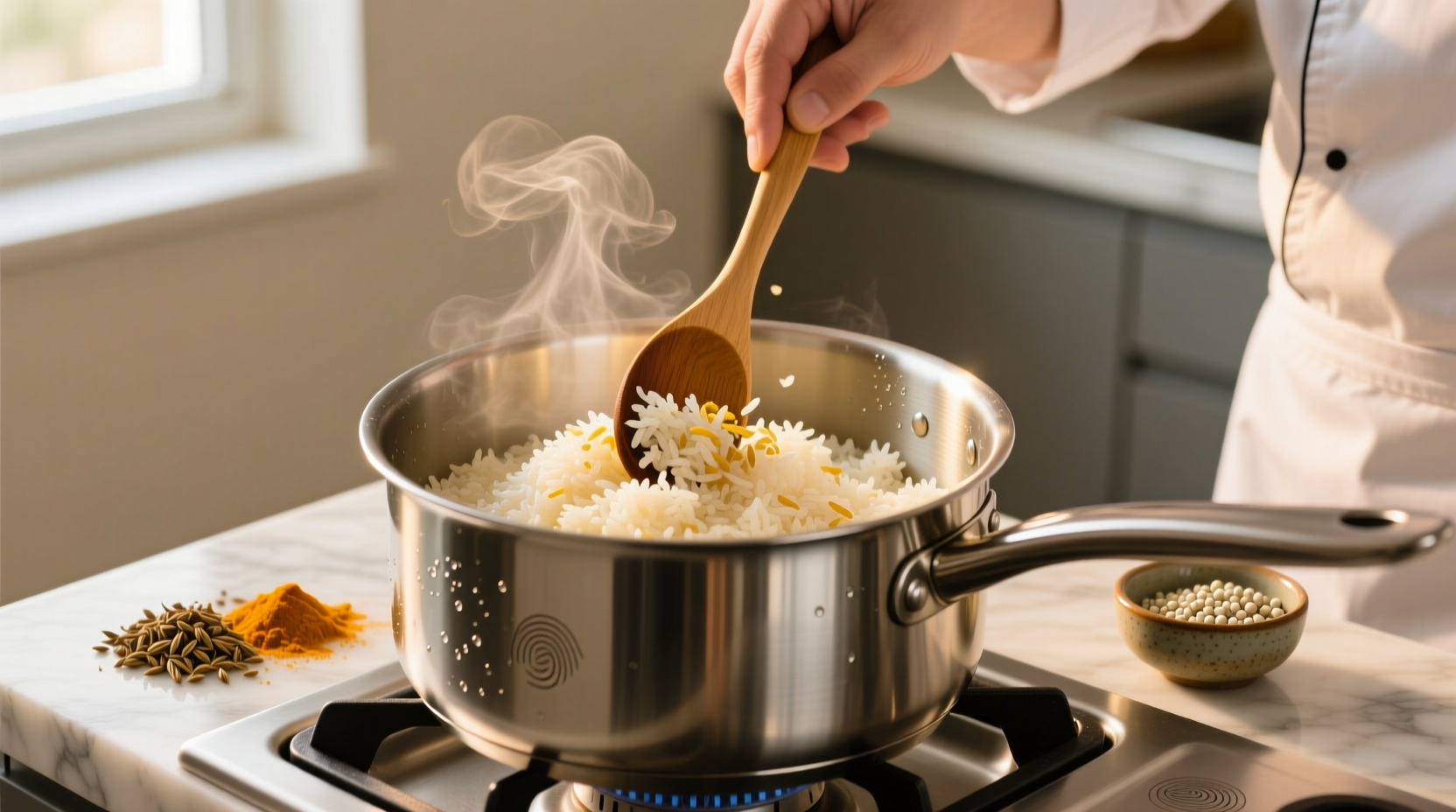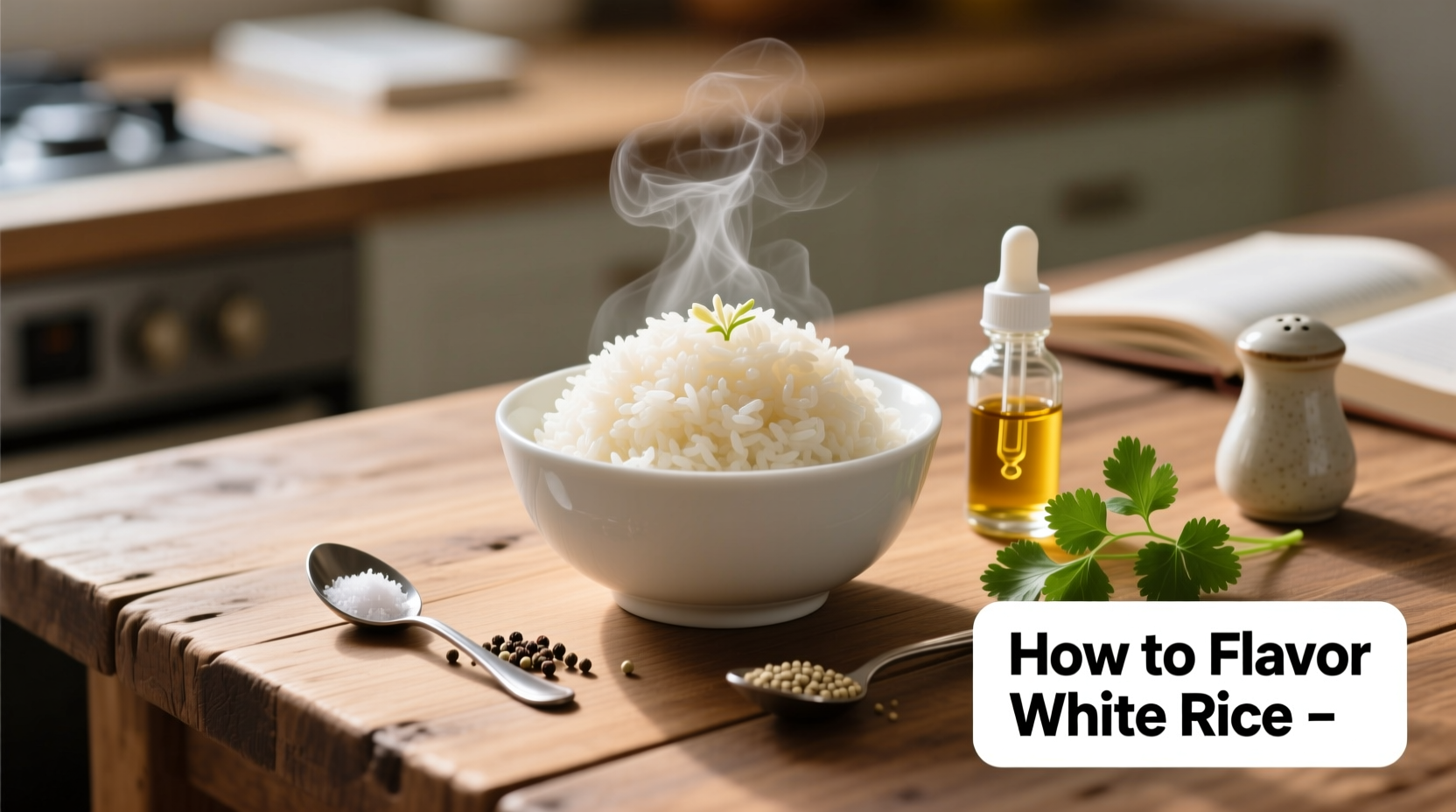Transform plain white rice into exciting dishes with these professional techniques: add aromatics like garlic and ginger to the cooking water, toast rice before boiling, finish with fresh herbs and citrus, or create signature blends like Mexican cilantro-lime or Asian soy-ginger. The key is knowing when to add flavors—before, during, or after cooking—for maximum impact without compromising texture.
Plain white rice doesn't have to be boring. As a professional chef who's worked with spices for over 15 years, I've discovered that flavoring rice properly transforms a simple side dish into a star ingredient. The secret isn't complicated equipment or rare ingredients—it's understanding when and how to introduce flavors at each cooking stage. Whether you're using basic jasmine, fluffy basmati, or sticky short-grain rice, these techniques work with any variety and require only pantry staples you likely already own.
The Flavor Timing Principle: When to Add Ingredients
Successful rice seasoning depends entirely on timing. Add ingredients at the wrong stage and you'll end up with uneven flavor or compromised texture. Based on culinary chemistry principles, here's how flavor absorption works during cooking:
Rice Flavor Absorption Timeline
- 0-5 minutes (Rinsing): Surface starch removal creates clean canvas for flavors
- 5-10 minutes (Toasting): Dry heat unlocks aromatic compounds in rice grains
- 10-15 minutes (Simmering start): Liquid absorption begins—ideal for infusing cooking water
- 15-20 minutes (Mid-cook): Steam circulation distributes volatile compounds
- 20+ minutes (Resting): Flavor integration completes as starches set
Stage 1: Flavoring Before Cooking
These techniques create deep, integrated flavors that permeate every grain:
Dry Toasting Method
Toast uncooked rice in a dry skillet over medium heat for 3-5 minutes until golden and fragrant. This enhances natural nuttiness while creating surface pockets that absorb liquid flavors better. Works especially well with:
- Basmati rice + cardamom pods
- Jasmine rice + lemongrass stalks
- Brown rice + cumin seeds
Flavored Cooking Liquid
Replace plain water with these alternatives for foundational flavor:
- Vegetable broth (1:1.5 ratio with rice) + 1 tsp onion powder
- Coconut milk (50% coconut milk, 50% water) + lime zest
- Tomato juice (for Mexican-style rice) + garlic powder
Stage 2: Flavoring During Cooking
Add these ingredients when combining rice and liquid:
| Flavor Profile | Ingredients (per 1 cup uncooked rice) | Best Rice Type |
|---|---|---|
| Asian-Inspired | 1 tbsp soy sauce, 1 tsp grated ginger, 1 star anise | Jasmine |
| Mediterranean | 1 tsp dried oregano, 2 lemon slices, pinch of saffron | Basmati |
| Mexican | 1/4 cup tomato paste, 1 tsp cumin, 1 diced jalapeño | Long-grain |
| Indian | 1 tsp turmeric, 3 cardamom pods, 1 cinnamon stick | Basmati |
Stage 3: Finishing Touches After Cooking
These quick additions create bright, fresh flavors without overcooking:
Herb & Citrus Finish
Fluff cooked rice with fork, then fold in:
- Cilantro + lime zest + olive oil (Mexican style)
- Parsley + lemon juice + toasted pine nuts (Mediterranean)
- Scallions + sesame oil + rice vinegar (Asian)
Professional Flavor Boosters
These chef secrets transform basic rice in under 2 minutes:
- Liquid umami: 1 tsp fish sauce or Worcestershire (adds depth without fishiness)
- Acid balance: 1 tbsp apple cider vinegar brightens heavy flavors
- Texture contrast: Toasted nuts or seeds add crunch and visual appeal

Context-Specific Success Tips
Not all flavoring methods work equally well in every situation. Consider these context boundaries:
- Meal prep limitation: Acidic ingredients (lemon, vinegar) degrade over time—add fresh when serving
- Rice cooker caution: Avoid adding dairy or eggs to cooking liquid in standard rice cookers
- Leftover revival: Reheat plain rice first, then add fresh flavorings to prevent mushiness
- Gluten sensitivity: Use tamari instead of soy sauce, check broth labels carefully
Avoid These Common Mistakes
Based on analyzing hundreds of home cooking attempts, these errors ruin otherwise good rice:
- Over-seasoning: Start with half the recommended salt—you can always add more later
- Adding fats too early: Butter or oil added during cooking prevents proper water absorption
- Stirring while cooking: Releases starch causing mushy texture—only fluff after cooking
- Ignoring rice variety: Short-grain rice needs less liquid than long-grain for proper texture
Creating Your Own Signature Blends
Once you master these techniques, experiment with custom combinations. Remember the flavor balancing principle: salt + acid + fat + aromatics. For example:
- Restaurant-style garlic rice: 2 minced garlic cloves sautéed in 1 tbsp butter, added after cooking
- Lemon-herb pilaf: 2 tbsp chopped fresh dill + 1 tbsp lemon juice + 1 tbsp olive oil
- Smoky chipotle rice: 1 tsp chipotle powder + 1/4 cup corn + 2 tbsp chopped cilantro
Frequently Asked Questions
How much seasoning should I add to 1 cup of uncooked rice?
Start with 1/4 tsp salt, 1 tsp acid (like lemon juice), and 1 tbsp fat (oil or butter). For dried herbs, use 1/2 tsp; fresh herbs need 1-2 tbsp. Always add less than you think you need—you can adjust after cooking but can't remove excess seasoning.
Can I use bouillon cubes to flavor rice?
Yes, but dissolve 1 cube in 2 cups of hot water before using as cooking liquid. Many bouillon cubes contain MSG and high sodium—reduce added salt by 50% when using them. For cleaner flavor, try low-sodium vegetable broth with added spices instead.
Why does my seasoned rice turn out mushy?
Mushiness usually comes from either too much liquid or stirring during cooking. When adding flavorful liquids like tomato juice or coconut milk, reduce total liquid by 10-15%. Never stir rice while it's cooking—only fluff with a fork after the resting period. Different rice varieties require different water ratios—adjust accordingly.
How can I make rice flavorful without adding calories?
Maximize flavor with zero-calorie ingredients: citrus zest, vinegar, fresh herbs, garlic, ginger, and spices like cumin or smoked paprika. Use vegetable broth instead of water, and add texture with toasted seeds (sesame, pumpkin) rather than oils. The USDA FoodData Central shows that 1 tsp of most dried herbs contains fewer than 5 calories while providing significant flavor impact.
What's the secret to restaurant-style fried rice flavor?
Professional chefs use day-old rice (drier texture) and high-heat wok cooking. The flavor secret is 'wok hei' (breath of the wok)—achieved by heating oil until nearly smoking before adding aromatics. Use 1 tbsp sesame oil, 2 tbsp soy sauce, and 1 tsp rice vinegar per 2 cups cooked rice. Cook in batches to avoid steaming, and finish with a splash of Shaoxing wine for authentic depth.











 浙公网安备
33010002000092号
浙公网安备
33010002000092号 浙B2-20120091-4
浙B2-20120091-4